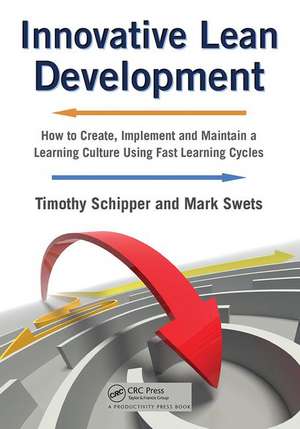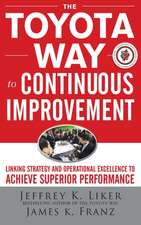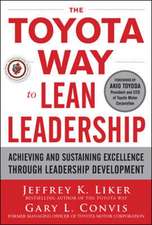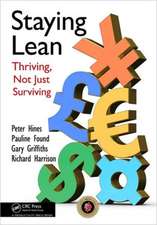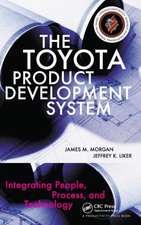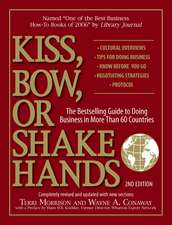Innovative Lean Development: How to Create, Implement and Maintain a Learning Culture Using Fast Learning Cycles
Autor Timothy Schipper, Mark Swetsen Limba Engleză Hardback – 20 sep 2017
| Toate formatele și edițiile | Preț | Express |
|---|---|---|
| Paperback (1) | 388.72 lei 6-8 săpt. | |
| Taylor & Francis – 28 iul 2009 | 388.72 lei 6-8 săpt. | |
| Hardback (1) | 986.91 lei 6-8 săpt. | |
| Taylor & Francis – 20 sep 2017 | 986.91 lei 6-8 săpt. |
Preț: 986.91 lei
Preț vechi: 1366.55 lei
-28% Nou
Puncte Express: 1480
Preț estimativ în valută:
188.87€ • 196.45$ • 155.92£
188.87€ • 196.45$ • 155.92£
Carte tipărită la comandă
Livrare economică 14-28 aprilie
Preluare comenzi: 021 569.72.76
Specificații
ISBN-13: 9781138438835
ISBN-10: 1138438839
Pagini: 200
Dimensiuni: 178 x 254 mm
Greutate: 0.45 kg
Ediția:1
Editura: Taylor & Francis
Colecția Productivity Press
Locul publicării:Oxford, United Kingdom
ISBN-10: 1138438839
Pagini: 200
Dimensiuni: 178 x 254 mm
Greutate: 0.45 kg
Ediția:1
Editura: Taylor & Francis
Colecția Productivity Press
Locul publicării:Oxford, United Kingdom
Public țintă
Professional and Professional Practice & DevelopmentRecenzii
"While innovation will always be messy business, the authors have eliminated much of the messiness. They have brought systematic thinking to something that does not lend itself to being systematic. … It shows how anyone can practice the principles of lean innovation."
— Bart Huthwaite, Sr., Huthwaite Innovation Institute
"This is truly a practitioner’s book. … If you follow the standards, you’ll be putting lean development in place, and more important, you’ll be ensuring the behaviors and practices that sustain it. … there is little mystery involved; these are things you can teach, expect, observe, and audit."
— David Mann, David Mann Lean Consulting
"… an interesting synthesis of all four schools, including the appropriate use of methods from lean manufacturing, especially management methods. … The authors provide a step-by-step plan for implementing rapid learning cycles in early product development. The illustrations and sample documents show what this process looks like in action. Additional chapters describe how to integrate rapid prototyping, reusable knowledge capture, and visual management into this system to eliminate the wastes of reinvention and excess project management overhead."
—Journal of Product Innovation Management, 2012
— Bart Huthwaite, Sr., Huthwaite Innovation Institute
"This is truly a practitioner’s book. … If you follow the standards, you’ll be putting lean development in place, and more important, you’ll be ensuring the behaviors and practices that sustain it. … there is little mystery involved; these are things you can teach, expect, observe, and audit."
— David Mann, David Mann Lean Consulting
"… an interesting synthesis of all four schools, including the appropriate use of methods from lean manufacturing, especially management methods. … The authors provide a step-by-step plan for implementing rapid learning cycles in early product development. The illustrations and sample documents show what this process looks like in action. Additional chapters describe how to integrate rapid prototyping, reusable knowledge capture, and visual management into this system to eliminate the wastes of reinvention and excess project management overhead."
—Journal of Product Innovation Management, 2012
Cuprins
The Six Principles of Innovative Lean Development. Facilitate Innovation with Fast Learning Cycles. How Multiple Learning Cycles Contribute to Innovation. How to Optimize Problem Solving Using Multiple Learning Cycles. How to Use Value Stream Mapping to Stabilize, Measure, and Control the Learning Process. How to Implement a Knowledge Capture and Retrieval System. The Role of Rapid Prototyping in Development. How to Apply Lean Management Principles to Innovation. Appendix A: Learning Cycle Planning Guide. Appendix B: Knowledge Capture A3 Template and Instructions.
Descriere
Shows how the lean approach can be very effective with those businesses that are innovation-based in terms of product development. This text focuses on the six key areas necessary for dramatic development: innovation, rapid prototyping, knowledge capture, learning cycles, process stabilization, and lean management standards.
